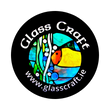The Galway Boat
Regular price €39Made to order- The Galway hooker boats are very popular around the shores of Galway Bay, and sometimes I am lucky enough to get a glimpse of these majestic boats from the window of my workshop, as they head off on their journey, no guessing where I get my inspiration from!!
These little box frames are an ideal gift for any home or office, made with a beautiful sky blue background and red glass for the traditional sails.
White wooden frame is appropriate size 4 inch x 4 inch, ready for hanging on a wall. Each unique piece of glass is individually hand painted, with layering of glass, and fired in a special glass kiln over 48hrs. Made in the glass studio in the Spiddal craft village, Co.Galway
( Larger size available on request, by special order ).
A little history....
The term ‘hooker’ is associated with ‘hook and line’ fishing, where long lines of baited hooks were drawn through the water and individual fish were caught when they went for the bait on each hook. This method of fishing, adopted by Galway fishermen, was referred to as ‘long-lining’. It influenced the labelling of the fishermen as ‘hookers’ and their boats became known as the Galway Hookers.
Hookers, often referred to as the ‘Workhorses of the West’, played an important role in the economy of the coastal communities in and around Galway Bay. They were used for fishing and carrying cargoes of turf, livestock, general supplies, lime, poitín (an illegal whiskey) and seaweed.
From the late 1940s the seaweed was brought to the Arramara factory in Connemara where it was converted into fertiliser and chemicals. The Hookers also carried passengers on routes that traversed the Bay and brought people in and out of small and large piers, markets and pilgrim sites. Long before the development of a reasonable road network, turf was transported from Connemara on Hooker boats across the bay to Aran and North Clare where bogland was scarce; livestock, limestone and general supplies made the return journey. A donkey and cart was then used to transport the materials to the local distributors.
The trade began to dwindle when turf was replaced by other fuels such as bottled gas and electricity.
The sails were made of a heavy textile called calico, which is an unbleached and often not fully processed form of cotton. The sails were proofed and cut locally. They were then covered in a solution made from tree bark or from a tar and butter mix.
The fishermen applied to the sails in order to weatherproof and protect them. This process is known as ‘barking the sails’ and it is the reason why Galway Hookers have their distinctive dark red or rusty brown coloured sails.




